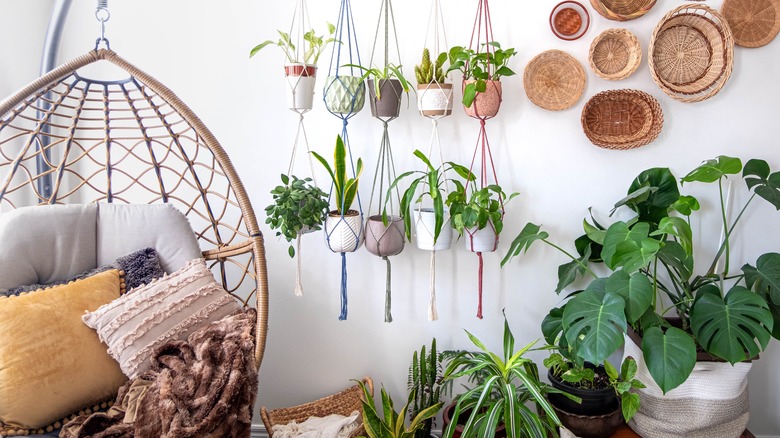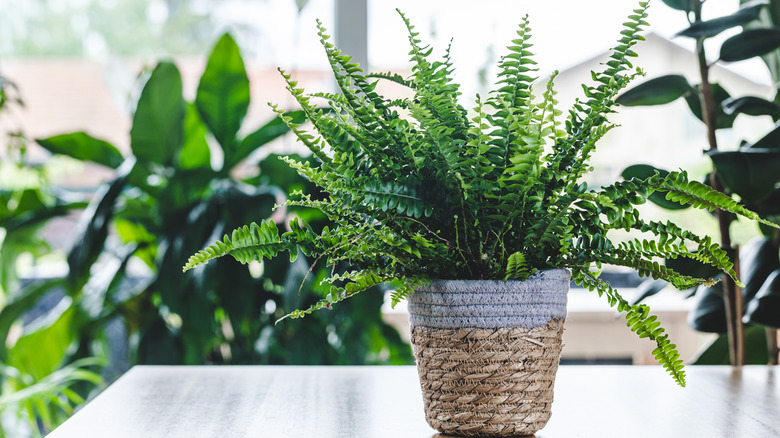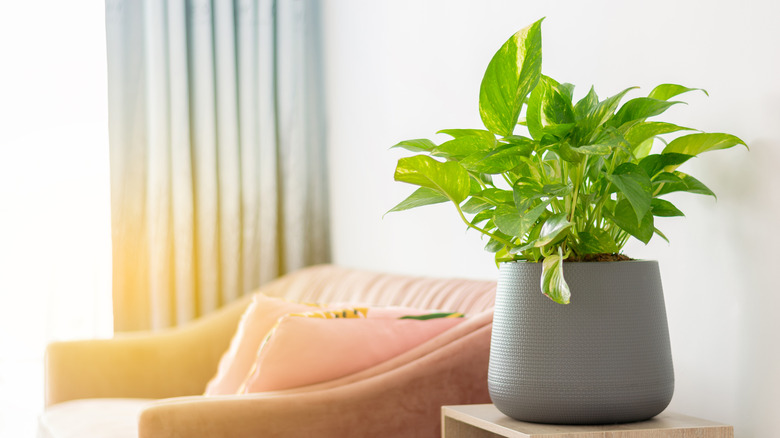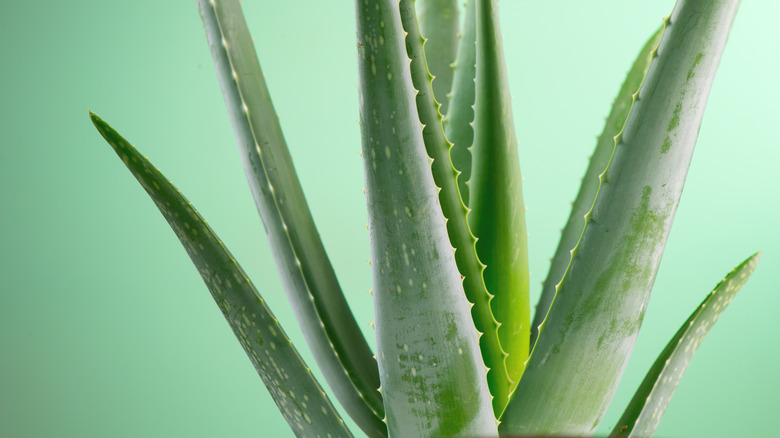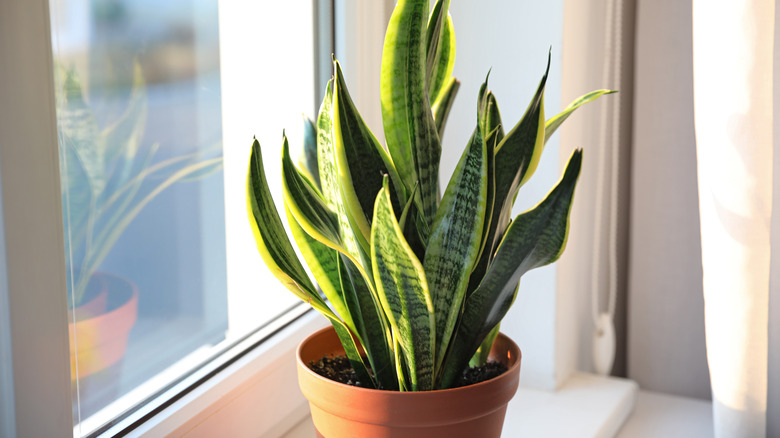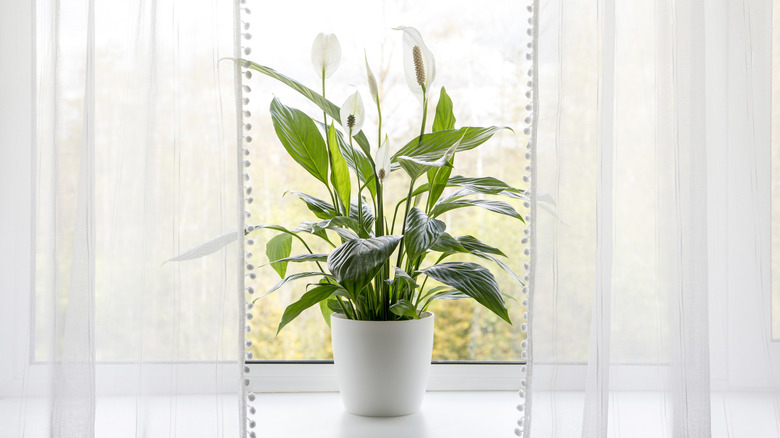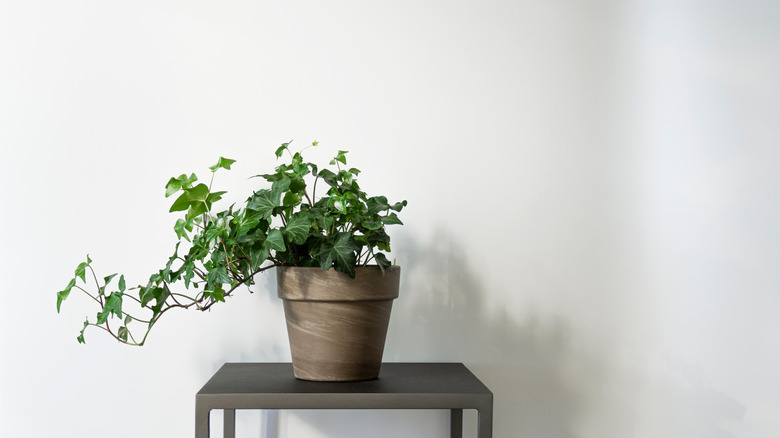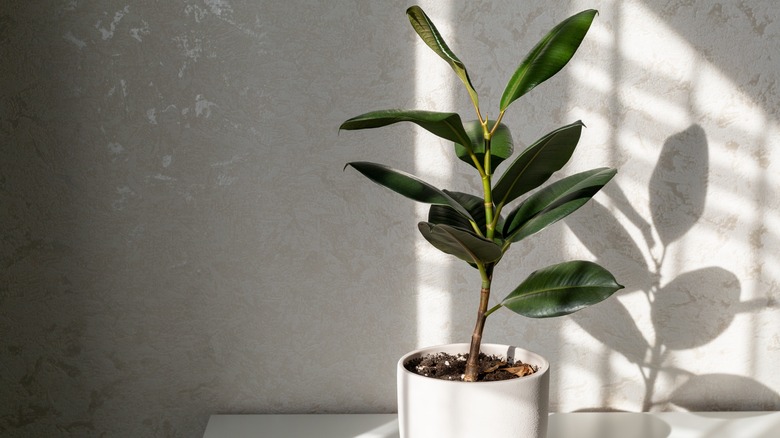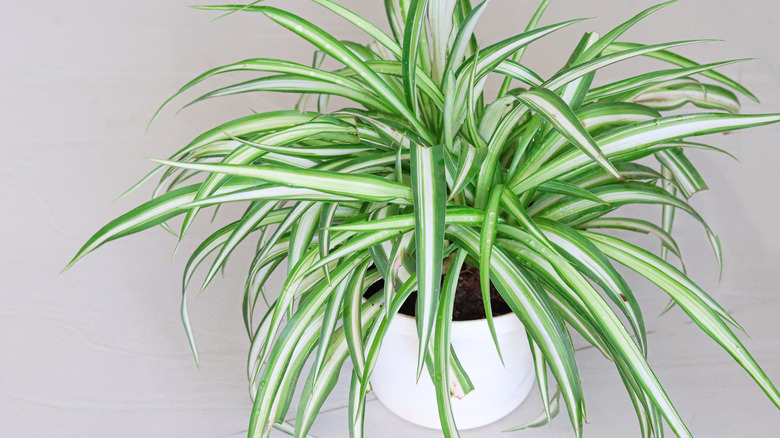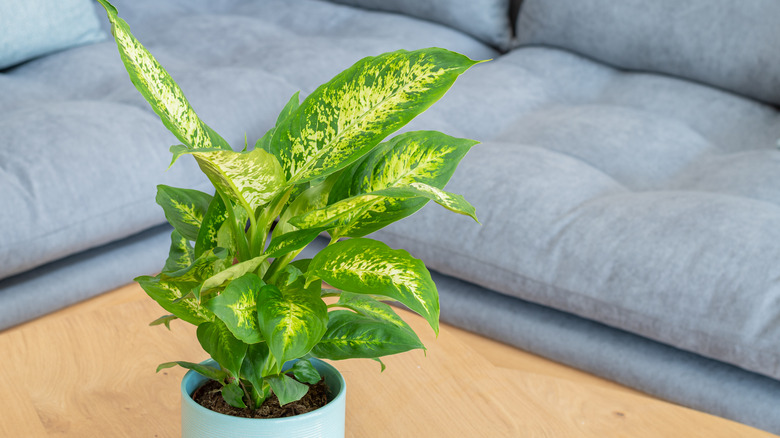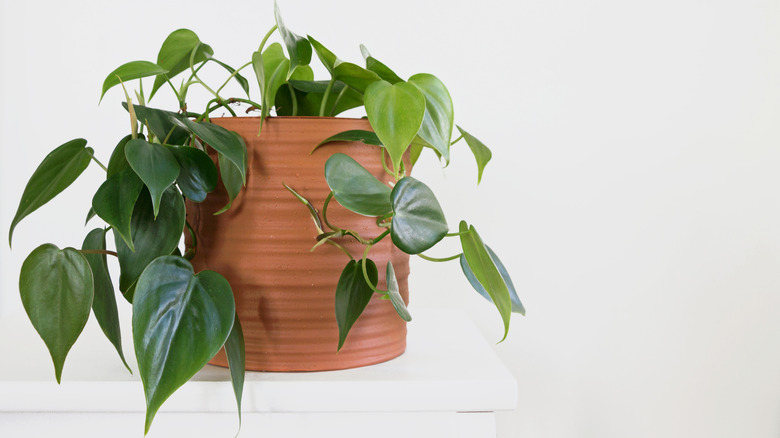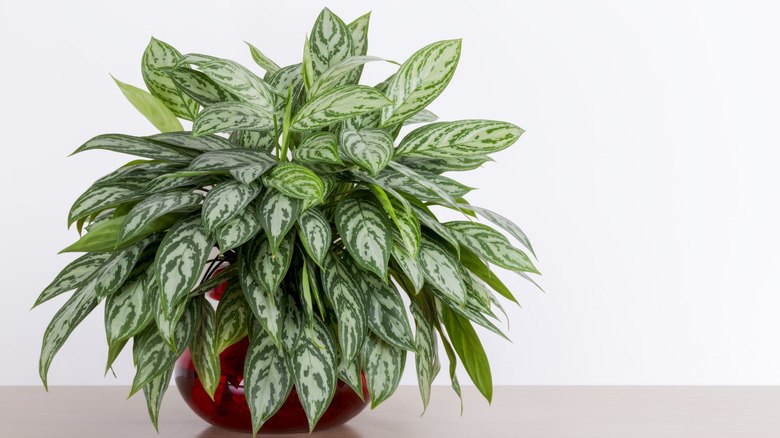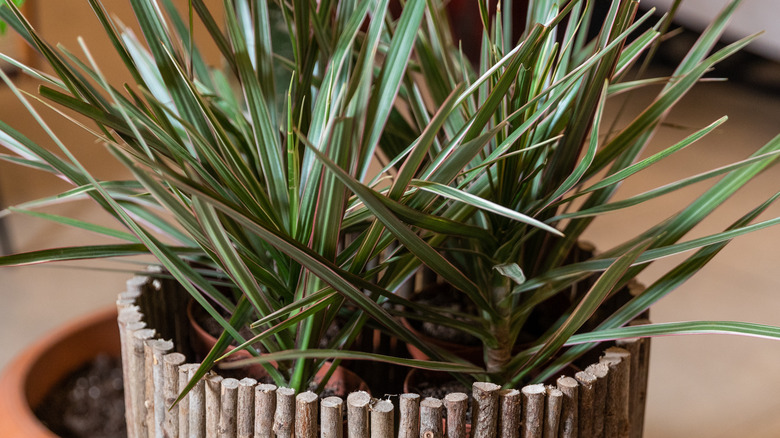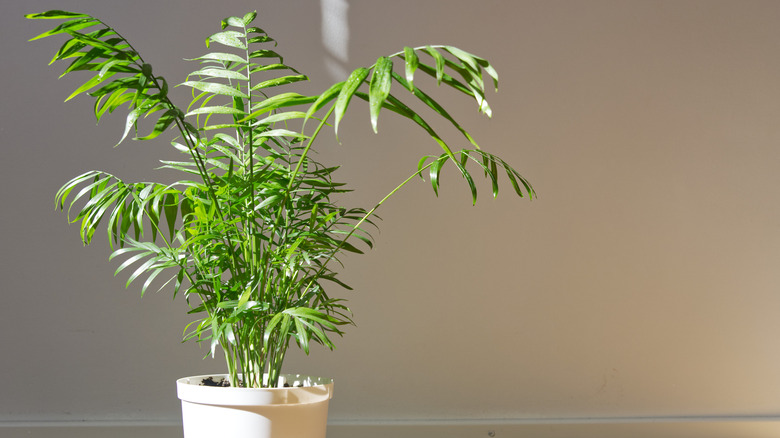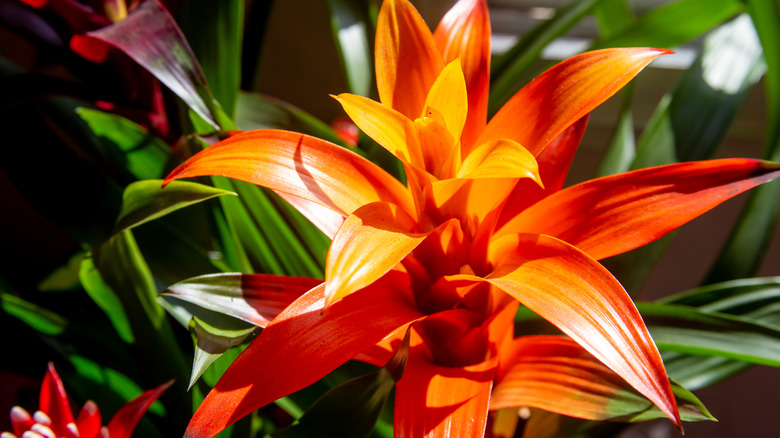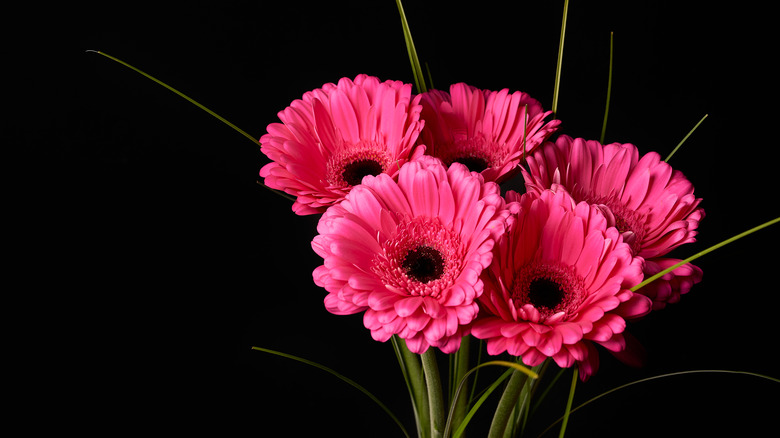15 Houseplants That Are Good For Your Health
Houseplants are popular for a reason — they can add an element of whimsy to any room in your home, and they often help to clean the air. In addition to their aesthetic benefits, some plants have medicinal properties that can be beneficial for your health. They can add a lot of beauty and life to any room or environment. These plants include some that are excellent for air purification and others that are good for providing greenery and scenery to set the air of relaxation around your home.
As Dr. Roger S. Ulrich wrote in his paper "Health Benefits of Gardens in Hospitals," that the greenery or color of flowers and plants helps to reduce time in the hospital, and in certain circumstances, those who had surgeries did not require as much pain medication than those who were not within view of any plants or flowers (via ResearchGate).
As great as they are for physical health, they are just as wonderful for cultivating a healthy mind, too. Caring for them can even give you a sense of accomplishment every day because you are taking care of something. Don't worry if you don't have a green thumb; the great thing about a lot of these houseplants is that many of them thrive on minimal attention and still grow beautifully.
1. Boston fern
Boston ferns (Nephrolepis exaltata, per Wisconsin Horticulture Division of Extension) are a popular houseplant that many people don't realize can act like a humidifier. By adding moisture to the air, they can help with dry skin and other respiratory problems, per Life Hack. They are also air purifying, removing toxins from the air. Boston ferns also offer greenery and freshness, adding cheer to any room they are in. Boston ferns are easy to care for and enjoy indirect sunlight. These plants can be kept in a pot or hanging basket.
Sunlight Needs: Indirect sunlight
Water Needs: Daily
2. Golden pothos
Golden pothos (Epipremnum aureum) is an easy-to-care-for vine with heart-shaped leaves. It's a popular beginner houseplant because it's hard to kill and needs very little maintenance. The vines can grow up to 6 feet long, so they are great in hanging baskets, or you may want to allow them to climb up. Almanac states that a few drops of liquid fertilizer each month will keep your golden pothos growing and thriving. These plants can help reduce toxins in the air and help chase away odors in the home.
Sunlight Needs: Bright indirect sunlight
Water Needs: Once weekly
3. Aloe vera
The aloe vera (Aloe barbadensis miller) plant is a succulent native to Africa but is found throughout the world (via National Library of Medicine). It has been used medicinally for centuries and is still a popular medicinal plant. The gel inside the leaves is soothing for sunburns and can help to heal wounds quicker. Aloe vera also purifies the air, making it a good choice for an indoor plant. It's easy to harvest the plant when you need to use it as well, per Healthline.
Sunlight Needs: Bright sun
Water Needs: Heavily once every two weeks
4. Snake plant
The snake plant (Sansevieria trifasciata), also known as mother-in-law's tongue, is a popular houseplant. What you may not know is that snake plants can help improve the air quality in your home, per Healthline. Snake plants release oxygen at night, which reduces the levels of harmful VOCs (volatile organic compounds) in the air. VOCs are emitted from paints, furniture, and other household products and can cause headaches, nausea, and other health problems. Snake plants can improve the air quality in your home for little money and effort.
Sunlight Needs: Bright, indirect sun
Water Needs: Every two weeks
5. Peace lily
Peace lilies (Spathiphyllum wallisii) are tropical plants native to South America. Peace lilies are often grown in homes and offices because they remove ammonia and other toxins from the air and can also reduce stress. They are also a good choice of houseplant because they help boost mental health and may even help you drift off easier at night, according to Petal Republic. They are a wonderful choice to keep in a place like a bedroom or an office.
Sunlight Needs: Bright, indirect sun
Water Needs: Once weekly, making sure to spritz the leaves
6. English ivy
English ivy (Hedera helix) is a plant that can be found throughout the United States. It has been used for centuries as a decorative addition to homes and gardens. This vine has been shown to purify the air and absorb mold, according to Allergy & Air. It also has anti-inflammatory properties, so it can be helpful for people with asthma or allergies. English ivy is easy to care for and can be grown in a variety of conditions.
Sunlight Needs: Partial to full sun
Water Needs: Once weekly, or when the soil feels dry (via Costa Farms)
7. Rubber plant
Rubber plants (Ficus elastica) are a beautiful addition to any home and have some impressive benefits! They are a popular houseplant because they are easy to care for and clean the air. They can grow up to 9 feet tall, so they are a good choice for a floor plant (via Our House Plants). According to One Green Planet, their larger leaves clear more toxins and VOCs out of the air. The leaves are a lovely waxy and dark green, and they have a beautiful trailing habit.
Sunlight Needs: Bright, indirect light
Water Needs: Once weekly
8. Spider plant
Spider plants (Chlorophytum comosum) are one of the easiest plants to grow and maintain. They add humidity to the air, which according to Ferns N Petals, can help ward off colds and the flu. Spider plants are also safe for pets and hard to kill, making them a great option for those who don't have a green thumb. They are a great starter plant for those who are looking to purchase their first house plant.
Sunlight Needs: Indirect light
Water Needs: Once weekly
9. Dumb cane
Dumb cane (Dieffenbachia seguine) is a popular houseplant due to its attractive variegated leaves (via House Plants Expert). What many people don't know is that dumb cane is also one of the best plants for absorbing carbon dioxide. In fact, it absorbs carbon dioxide better than most plants, according to Balcony Garden Web. This makes it an ideal plant for use in homes and businesses that want to improve the air quality. Its tropical look can bring a pop of color into your home as well.
Sunlight Needs: Bright, indirect
Water Needs: Every one to two weeks
10. Philodendron
Philodendrons (Philodendron squamiferum) are a favorite houseplant because of their easy care and attractive leaves. These leaves have a waxy texture to them, making them great at trapping dust from the air in their leaves, says Bloom Box Club. This makes them a great choice for people who suffer from allergies. Additionally, they humidify the air, making them ideal for people who live in dry climates. To keep your philodendron looking its best, mist it weekly and wipe down the dust from the leaves.
Sunlight Needs: Bright, indirect
Water Needs: Weekly
11. Chinese evergreen
One of the many benefits of having a Chinese evergreen (Aglaonema) as a houseplant is that it helps to remove benzene and formaldehyde from the air. These toxins are common in homes and offices. Adding a Chinese evergreen to your décor is also a great way to improve the air quality in your space, and it also has feng shui benefits by adding balance and harmony, as well as promoting positive energy flow to your environment, according to Petal Republic.
Sunlight Needs: Indirect
Water Needs: Weekly
12. Dragon tree
Dragon tree (Dracaena draco) is a popular indoor plant that is known for its gorgeous green to purple leaves. In addition to being aesthetically pleasing to look at, dragon trees also have practical benefits. They help rid the air of VOCs (volatile organic compounds) and increase humidity levels in the air, making them a great choice for homes and offices with poor air quality or dry environments. According to Plants Craze, they can also help lower stress levels and give a little mental boost as well.
Sunlight Needs: Bright, indirect
Water Needs: Every one to two weeks
13. Parlor palm
The parlor palm (Chamaedorea elegans) is a tropical plant that can grow up to 8 feet tall if well cared for. It is prized for its ability to produce oxygen and purify the air (via Rolling Nature). Parlor palms also reduce carbon dioxide levels in the air, making them a popular choice for homes. They have dark green fronds that add a touch of greenery to any space. Smart Gardener's Guide notes that if in the right light, the plant can sometimes bloom yellow flowers in the springtime.
Sunlight Needs: Indirect
Water Needs: Every one to two weeks
14. Bromeliads
Bromeliads (Bromeliaceae) are beautiful flowering plants that can be found in a variety of colors and shapes. These amazing plants also release oxygen at night, which can promote better sleep, according to Pro Flowers. Bromeliads are also relatively pest-free, making them a great choice for those who want a low-maintenance houseplant. Their bright blooms will also bring cheer and an air of happiness to any room they are set in.
Sunlight Needs: Bright, indirect
Water Needs: Weekly
15. Gerbera daisy
Gerbera daisies (Gerbera jamesonii, per Our House Plants) are beautiful plants that can add a splash of color to any room. What many people don't know is that gerberas also release a good amount of oxygen, and can help you sleep better, according to Ferns N Petals. The best place for optimal oxygen intake is next to a bed. They also increase humidity levels in indoor spaces, making them ideal for offices, homes, and other indoor areas. Gerberas come in various colors, so it's easy to find one that will match the décor of any room.
